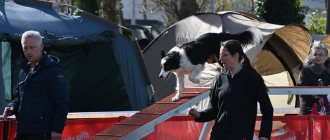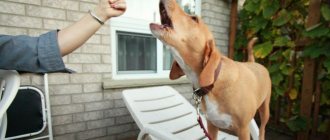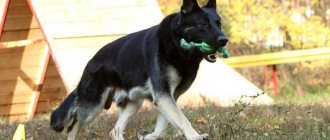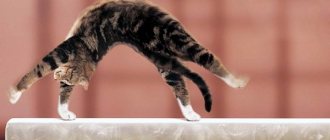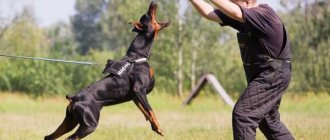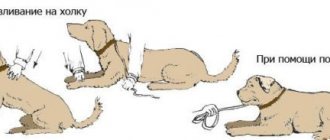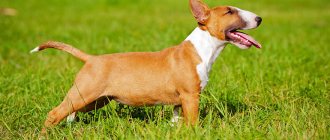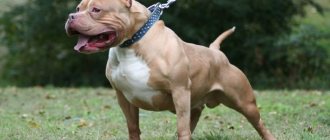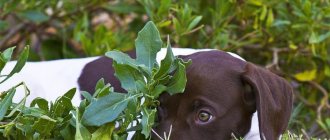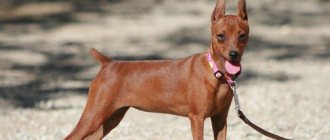The right things
Puppies of small breeds are often sold at the age of 2 months, when they already know how to eat on their own and are strong enough to move to a new family, then you should take care of the care, maintenance, and nutrition of the pet:
- 2 bowls for water and food, it is worth taking separate metal or ceramic ones with rubber suction cups on the bottom. Dog bowls that are one bowl separated by a partition are not suitable; food particles will always end up in the water.
- A cozy dog house, a basket with a soft mattress or a foam bed. The puppy loves to sleep on a soft and warm rug, so his personal place should be cozy.
- Tray and diapers. Breeders often train their puppies to nurse in diapers, which can be purchased at any pet store. The owner covers the tray (this item must be large enough for an adult dog) with a diaper and places it there after sleeping, feeding or playing. The litter box is not suitable for cats.
- Toys. These will be rubber squeakers, small balls or ropes, bones and soft toys; some kids love to play with an old slipper or wrestle with a huge plush hare. There are puzzle toys, balls or dumbbells with a funnel-shaped hole inside. Cookies or cheese are placed in it, and the pet plays with the toy for a long time, trying to get the treats.
- Collar and leash. For a Yorkshire Terrier, it is preferable to purchase a collar rather than a harness. This applies to show puppies whose fur becomes damaged by contact with the harness straps. The collar should be soft, the leash can be immediately used for growth: a tape measure leash or a leather one, matching the color of the collar.
- Flea collar. Pets living in an apartment are susceptible to fleas and ticks, which can enter the apartment through the entrance, balcony, or “arrive” on the owners’ shoes. It is advised to buy a collar designed specifically for babies, with herbal repellents.
- Clothes can be purchased as you grow. There is no need to buy summer clothes, let the baby roam freely, but in the off-season and winter, warm overalls or a waterproof blanket are necessary. Yorkies are not protected from the cold in any way, their paws are exposed to chemicals and salt in the winter, so winter boots will come in handy.
- A hairpin or rubber band for the tuft on the head, which collects hair that interferes with viewing. They acquire as they grow out bangs and devices in which the long hair on the dog’s body is wrapped.
- Grooming items. The puppy has short, soft fur, but in order for it to grow and remain beautiful and silky, the pet needs to be bathed regularly, accustomed to blow-drying and combing. Shampoo for Yorkies, a comb and a soft brush, a hair dryer and a towel will be necessary from the first days.
- Lotions for treating ears and eyes, cotton pads - all this can be bought at a good pet store. The eyes are wiped in the morning, the ears are cleaned once a week.
- A carrying bag is a necessary thing for a pet when you need to take it to a clinic or exhibition for vaccination. Buy plastic carriers with hard walls, in which the baby is not in danger. Bags with soft, fabric sides are uncomfortable for the dog, and there is a risk of pinching the pet.
Take the Attention Test! Find 10 differences! (click right here!)
Find the answer Are you bothered by some problem or question? Enter “Breed” or “Name of the problem” into the form, press Enter and you will find out everything about the issue that interests you.
If you plan to leave your pet alone for a long time, then you need to purchase a special cage-aviary in which it will remain when the owners are not at home. The cage is equipped with a soft lounger, a bowl of water, a tray with a diaper and the pet’s toys are placed in it. The dog crate must be large.
When the owners are at home, the cage door should always be open, and tidbits can be thrown in regularly so that the cage is associated only with pleasant surprises.
Preparing the house for the arrival of a dog
The first day in a new home is a difficult period for both the Yorkshire Terrier and the owner. The baby may be frightened by an unfamiliar environment and whine loudly, feeling lonely. But gradually the spirit of the explorer will prevail and he will explore the territory with interest.
- It is important to create a cozy atmosphere and purchase in advance everything you need that may be useful in caring for the puppy.
York will need:
- Bed (with high sides) or soft booth
- Leather collar, leash (optimal tape measure length – 5 m)
- 2 ceramic bowls on a stand
- 2 terry towels (for swimming and a small one for washing paws after walks)
- Tray
- Disposable diapers (size 60x40)
- Toys (latex or soft without small parts)
- Cosmetics for bathing: shampoos (with lanolin, protein), balms, sprays for combing out tangles
- Professional food
- Treats
- Metal comb (with rounded teeth) and slicker brush
- Scissors
- Electric safety razor (for removing hair between paw pads)
- Nail clipper or nail clipper
- Elastic bands, bows, hairpins
- Additionally, you may need a carrying bag, a hairdryer and an aviary
Vaccination schedule
At 2 months, the puppy no longer has maternal antibodies that can protect it from the disease, so at this age the first vaccination can be given.
Often vaccines are purchased at veterinary pharmacies, or the pet is taken to a veterinary clinic. Experienced breeders advise using vaccines from foreign manufacturers to immunize Yorkies: Nobivak or Vanguard. Domestic vaccines are sometimes ineffective and do not form an adequate immune response.
Before vaccination, they give anti-worm tablets, then 10 days later they give the first vaccination. Nobivak DHPPI is often used, protecting the baby from enteritis, plague, hepatitis, adenovirus and parainfluenza. This is a dry vaccine that is diluted with Diluent solvent. After 3 weeks, re-vaccination is carried out with the same vaccine.
Quarantine lasts the entire period of primary vaccination, including the interval between vaccinations and 2 weeks after the second. The puppy can then go outside, attend shows and play with other dogs.
After changing teeth, at seven months a third vaccination is given with the Nobivak DHPPI vaccine, but Nobivak L is used as a solvent, which protects the dog from leptospirosis. In the year of the Yorkshire terrier, Nobivak DHPPI + Nobivak LR are vaccinated, that is, the baby is protected from common infectious diseases, from rabies. Vaccination is repeated annually.
According to the rules, all dogs must be vaccinated against rabies from the age of three months, but the vaccine is toxic, often causes allergies and can affect the further growth and development of the pet. Only those puppies that live in quarantine zones or participate in exhibitions are vaccinated against rabies according to age.
Basic command training
Training will help your inquisitive Yorkie avoid a lot of trouble. For training you will need: a good mood, 10 minutes of free time and a few treats. The owner's cheerful and cheerful voice, together with his favorite delicacy, will turn any workout into an exciting game.
“Come to me”: throw a ball or other toy to the dog, then lure him to you with a treat, say the pet’s name and command. If the puppy runs up immediately, reward him.
“Place”: When sitting next to your dog, hold the treat where it can be seen. Go to the couch and say the command. When the puppy comes, place him in his place and apply light pressure to the rump. For following the command, praise the baby and give him a tasty piece.
“Fu”: the command is used only when it is necessary to stop any action. To do this, say it in a stern voice and lightly tug the leash. It is worth approaching the study of this command when the training stage has been completed and the owner has managed to gain the trust of the dog.
- Yorkshire Terriers are easy to train, so teaching them other commands is not difficult.
Genetic abnormalities
- Necrosis of the femoral head - begins at the age of 6 months, reaches its maximum development by one year. Characterized by lameness in one of the hind limbs, atrophy or reduction of the femoral muscle, difficulty standing up. Treatment is surgical.
- Patella luxation is characterized by the dog walking on a bent paw, lameness and the inability to straighten the paw. Treatment is surgical.
- Instability of the first and second cervical vertebrae leads to their displacement and pinching of the spinal cord, characterized by acute pain, suffocation, and paralysis of the limbs. Treatment is surgical.
- The presence of an abnormal vessel that directs blood bypassing the liver, cleansing it. The symptoms are similar to those of acute poisoning or intoxication; convulsions, lethargy, and depression are observed. It can appear in puppyhood, and the larger the lumen of the vessel, the more severe the dog’s condition. Treatment is surgical.
- Deformation or collapse of the trachea, manifested by coughing and periodic attacks of suffocation. Caused by a narrowing of the lumen of the tracheal cartilage due to its laxity. The onset of the disease is provoked by obesity and inflammatory diseases, which progresses over time.
- Acute pancreatitis is a common disease in these dogs. It begins acutely, with vomiting, abdominal pain and fever, and diarrhea. Treatment is conservative.
Nutrition
A 2-month-old puppy needs to be fed several times a day, some babies need 3 times, some require four feedings a day.
When a dog is taken from a breeder, you need to ask what the baby ate. More often, breeders feed small Yorkies with dry food designed specifically for this breed. If in the future you plan to feed your dog at home only natural products, you need to switch it to natural food a couple of weeks after purchase. It is necessary to give the puppy time to adapt to his new living conditions, and then gradually transfer him to a new diet.
Natural nutrition
For a two-month-old puppy, it is necessary to include in the diet daily:
- Porridge from a mixture of cereals (rice, buckwheat, rolled oats);
- Raw beef meat;
- Boiled carrots;
- Vegetable oil;
- Cottage cheese and any fermented milk products;
- Sukam - milk.
Often porridge is boiled from cereals in water, then carrots are added to it (you can add grated raw carrots to hot porridge), vegetable oil and beef, cut into small pieces and scalded with boiling water. Porridge is given 3 times a day, dairy products once. You can diversify the menu with raw sea fish, or give a raw chicken egg once a week. Give puppies vitamins containing calcium and phosphorus.
For an adult animal, the diet remains the same; an adult Yorkie is fed 2 times a day, with the first feeding consisting of cottage cheese or kefir. Three meals a day are necessary for up to a year, for puppy dogs in the second month of pregnancy and for lactating ones.
Ready-made feed
It is advisable to buy super-premium dry food, only these foods contain the entire range of vitamins and are balanced in fat content:
- “Eukanuba Yorkshire Terrier”: food granules are covered with a film that protects teeth from the appearance of stone, contains all the necessary vitamins and amino acids. For an adult dog, 50 grams is enough. Price - 600 rubles per kilogram.
- "ROYALCANINYorkshireTerrier": contains biotin and vegetable oils that enhance coat color. There is food designed for Yorkie puppies. Cost - 350 rubles per kilogram.
- "Proplan": ideal food for small breeds, strengthens the immune system, prevents obesity. Cost - 350 rubles per kilogram.
- Acana: gluten-free, corn-free, low-carb, small amounts of oats. Natural products and environmentally friendly ingredients, for dogs prone to allergies. Price: 600 rubles per kilogram.
- "Hill's": food for age groups, for animals on a therapeutic diet. The cost per kilogram is 380 rubles.
What is necessary?
If you become the owner of this charming decorative companion for the first time, then you should think about the list of necessary tools for daily grooming, since this breed requires very careful daily care.
To keep a Yorkie, regardless of whether it is a show dog or just a pet, you will need:
- Comb – a comb with frequent rounded teeth. Ideally, it would be metal and have a comfortable handle.
- Massage brush with a wooden handle to remove static electricity.
- Brush with natural bristles.
- Sprayer . The bubble should not be very large. A liquid is placed in it, which is necessary for hair care.
- Manicure scissors with rounded edges.
- Hairdresser's scisors.
- Shaver.
- Paper for curl papers and rubber bands for securing them in different sizes.
- A robe or overalls worn with the hair wrapped in paper.
- Elastic bands and hairpins for bangs.
- Special care cosmetics, which include not only shampoo and conditioner, but other specialized compounds that help keep the Yorkshire Terrier's coat in good shape.
Prohibited Products
Both puppies and adult Yorkies should not be given the following foods:
- Fat meat;
- Smoked meats, boiled sausages, frankfurters;
- Sugar and chocolate;
- Any confectionery products that contain margarine, sugar;
- Chicken bones, after 4 months - any bones;
- River fish, salted or smoked fish;
- Any food from the table contains too much salt and fat.
Don’t think that it’s easy to feed a small dog from the table, that you don’t need to buy food or cook for it separately.
Everything that people eat is harmful to the dog’s health, even delicious and healthy cottage cheese pancakes, scrambled eggs or chicken soup. The Yorkie's pancreas is vulnerable, so attention must be paid to its nutrition.
Starting to raise a Mini Yorkie puppy
The Yorkshire Terrier is a dog that has high, by dog standards, intelligence. After the dog has settled in new conditions, you need to begin the process of socialization and education of the dog. First of all, you should teach her to sleep in her place. To do this, you need to choose a comfortable house or bed and not allow you to stay in the master’s bed even “just once.”
Yorkies, unlike many other purebred dogs, are capable of remaining alone for a long time. In order for the baby to get used to this as quickly as possible, you need to leave him alone earlier. Otherwise, when left alone, the dog may experience stress, whine and howl.
Walking rules
Behavior during walks in the fresh air is another skill that should be developed in the baby. The dog should be accustomed to street noises, how to behave with unfamiliar subjects, and also not to grab everything from the ground.
It is important to teach your Yorkie the rules of walking
Grooming
The Yorkie's coat grows throughout its life, so a small puppy must immediately be accustomed to long and frequent procedures of washing, drying and combing. A groomed pet is washed once every 3 weeks, a show pet with long hair - once every ten days.
To properly wash your dog, you must follow the following instructions:
- The dog is placed in the bathtub, on a towel or rubber mat to prevent it from slipping. A Yorkie can easily sprain or break a leg by jerking violently on a slippery surface.
- Shampoo suitable for wool is diluted in an empty plastic bottle in advance.
- The dog is wetted by pouring warm water from the shower, then diluted shampoo is applied twice, rinsing it off until the coat squeaks.
- First, wash the head and face, making sure that the inside of the ears remains dry.
- Lastly, apply the balm, then rinse it off thoroughly.
- The dog is wrapped in a thick towel, all the water is squeezed out of the fur, and then they start drying it with a hairdryer. The room should be warm, and the air from the hairdryer should not be excessively hot.
How to care for the fur of Yorkshire Terriers
Your pet should wash its paws after a walk and be sure to give it a full bath once every 10 days. Choose a special shampoo based on your coat type.
You can wash your Yorkie in the sink or in the bathroom, placing the dog on a rubber mat. Be carefull. If the dog wants to break away from you, it will get injured. To prevent water from getting into your ears, cover them with small cotton swabs.
Protect your Yorkie's eyes from water. Wet the fur generously and do not frighten your pet with strong water pressure from the shower. After applying shampoo and massaging the dog’s body, thoroughly rinse off any remaining shampoo. The wool will be especially shiny if you use conditioner.
After bathing and rinsing, lightly wring out the fur with your hands, let the pet shake itself off and wrap it in a towel. Brush your dog thoroughly with a metal-toothed brush. Brush your dog regularly . Don't let hairballs form. Using oil will make combing easier.
Teeth and eye care
Wipe your eyes every day with a cotton swab dipped in a special lotion.
A separate cotton pad is needed for each eye so that if there is bacterial flora, it will not be transferred to the healthy eye. The dog is seated and a cotton pad is carefully passed from the outer corner of the eyelid to the inner one, collecting possible secretions. Brushing your teeth is a necessary activity for your Yorkie; your baby is taught to do this from the age of 4 months, as soon as the first permanent teeth appear. The baby is placed on his knees, his face is held with one hand, and his teeth are carefully brushed with the other. For the first few times, until the dog gets used to this procedure, toothpaste (you can buy it at a pet store) is not used. There is no need to rinse your pet's mouth.
You should clean your ears after each wash, at least once a week. You need to prepare dry cotton pads and ear lotion. Wipe the inside of the ear with a damp disc, then wipe dry with a paper towel.
Purchasing a Yorkshire Terrier is a big responsibility and a lot of trouble. Caring for a dog at home, proper feeding and treatment of the pet can take a lot of time, but for this the little dog will reward the owners with great love and give a lot of pleasant moments.
How to care for a Yorkshire Terrier - video
We invite you to watch a video where the owner of several Yorkshire terriers talks about caring for a Yorkshire terrier . Yorkies will also show off their fashionable wardrobe, and their owner will talk about her pets’ favorite treats.
I wonder what your pet’s favorite dish is? Share your experience caring for a Yorkie. What hairstyles do you give your baby? And if you have any questions, let's discuss them below in the comments .
Share
Leave a review
How often to walk
A Yorkie puppy should be taught to walk gradually, first he is taken outside in his arms and walked for a short time, after a while you can start carrying him in a bag. And only when he gets used to it, you can put the puppy on the grass for a while if the weather is good outside.
You should only walk with this curious dog using a roulette wheel. A walk of about an hour a day is enough to satisfy your Yorkie's activity requirements. Although Yorkies have long hair, they do not warm well due to the lack of undercoat. For walks, it is better to wear overalls and shoes on your dog.
How to build the education process
If you want to raise a loyal and devoted friend, you will need to spend a lot of effort and patience. The training process should begin from an early age - the puppy should immediately be prohibited from doing those things that will not be allowed later. If the moment is missed, it will be almost impossible for you to explain to the dog why today you can’t do what was possible yesterday.
It is necessary to start training on time, otherwise certain difficulties will arise with this process in the future.
Before training your pet, let him get used to the new place and understand his name - teach him to immediately respond to it. The training process is carried out directly by the owner - while observing the following rules:
- Earn the puppy's complete trust;
- Be patient;
- Do not forget that classes should be regular;
- Punish and reward on time - if you miss the moment, the dog will not see the cause-and-effect relationship;
- Start with the simplest things, gradually complicating the tasks;
- Try to interest the dog;
- Take into account all the character traits of your student.
Training sessions must be regular

